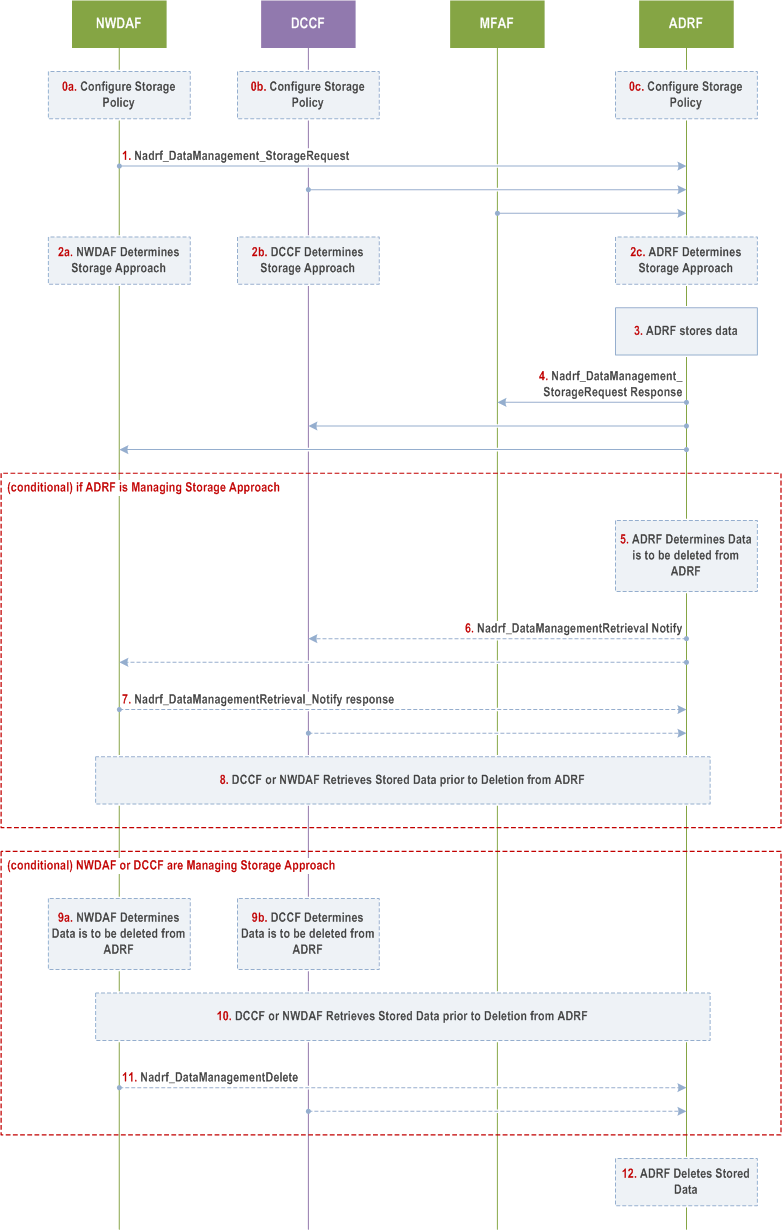Content for TS 23.288 Word version: 19.1.0
1…
4…
5…
5A…
6…
6.1.3
6.1.4…
6.1.4.4…
6.1.5…
6.1A…
6.1B…
6.1B.2.3…
6.1C
6.2…
6.2.3…
6.2.6…
6.2.6.2
6.2.6.3…
6.2.6.3.3
6.2.6.3.4
6.2.6.3.5
6.2.6.3.6…
6.2.7…
6.2.8…
6.2.9…
6.2.13…
6.2A…
6.2B…
6.2B.3
6.2B.4…
6.2C…
6.2D…
6.2E…
6.2F…
6.2H…
6.2H.2.2…
6.2H.2.3…
6.2H.2.4…
6.3…
6.4…
6.5…
6.6…
6.7…
6.7.3…
6.7.4…
6.7.5…
6.8…
6.9…
6.10…
6.11…
6.12…
6.13…
6.14…
6.16…
6.17…
6.18…
6.19…
6.20…
6.21…
6.22…
6.23…
7…
7.4…
7.7…
7.9…
8…
9…
10…
6.2B Analytics Data and ML Model Repository procedures
6.2B.1 General
6.2B.2 Historical Data and Analytics storage
...
...
6.2B Analytics Data and ML Model Repository procedures |R17| p. 131
6.2B.1 General p. 131
Collected data and analytics may be stored in ADRF, using procedure as specified in clause 6.2B.2 and clause 6.2B.3. Collected data and analytics may be deleted from ADRF, using procedure as specified in clause 6.2B.4.
ML Model may be stored in ADRF, using procedure as specified in clause 6.2B.5. ML Model may be deleted from ADRF, using procedure as specified in clause 6.2B.6. ML Model(s) may be retrieved from ADRF, using procedure as specified in clause 6.2B.7.
6.2B.2 Historical Data and Analytics storage p. 131
The procedure depicted in Figure 6.2B.2-1 is used by consumers (e.g. NWDAF, DCCF or MFAF) to store historical data and/or analytics, i.e. data and/or analytics related to past time period that has been obtained by the consumer. After the consumer obtains data and/or analytics, consumer may store historical data and/or analytics in an ADRF. Whether the consumer directly contacts the ADRF or goes via the DCCF or via the Messaging Framework is based on configuration.
The consumer may include in the storage request the DataSetTag attribute which the data records are to be associated to when stored by ADRF. The DataSetTag attribute is defined in Table 6.2B-1. Data records can be associated to multiple DataSetTag attributes.
| Information | Description |
|---|---|
| DataSetTag | Identifies the data set. |
| DataSetDescription | Provides human-readable information about the characteristics of the data set. |
The consumer may include in the storage request the Data Synthesis and Compression (DSC) information. The detail of DSC information is up to implementation, which is out of 3GPP scope.

Step 0a-c.
Conditional on ADRF Managing the Storage Approach
NWDAF, DCCF or ADRF are configured with default operator storage policies as described in clause 5B.1.
Step 1.
The consumer sends data and/or analytics to the ADRF by invoking the Nadrf_DataManagement_StorageRequest (collected data with timestamp, analytics with timestamp, Service Operation, Analytics Specification or Data Specification, Storage Handling information, optionally DataSetTag, optionally DSC information) service operation. The NWDAF or DCCF may provide notification endpoint information to the ADRF for use by the ADRF to send notifications (implicit subscription) alerting the DCCF or NWDAF that data are about to be deleted (see step 6).
Step 2a-c.
Based on Storage Handling information (if available) and Storage Policy, the ADRF, DCCF or NWDAF determines the Storage Approach (lifetime for storing data and whether consumer is notified prior to data deletion).
Step 3.
The ADRF stores the data and/or analytics sent by the consumer. The ADRF may, based on implementation, determine whether the same data and/or analytics is already stored or being stored based on the information sent in step 1 by the consumer NF and, if the data and/or analytics is already stored or being stored in the ADRF, the ADRF decides to not store again the data and/or analytics sent by the consumer. If the DataSetTag attribute is included for data and/or analytics already stored or being stored, then ADRF associates the data records with such DataSetTag.
Step 4.
The ADRF sends Nadrf_DataManagement_StorageRequest Response message to the consumer indicating that data and/or analytics is stored, whether the ADRF determined at step 3 that data or analytics is already stored and the Storage Approach.
Step 5.
The ADRF determines that the lifetime of the stored data or analytics has expired (according to the Storage Approach).
Step 6.
If indicated by the Storage Approach, the ADRF sends a notification alerting the DCCF or NWDAF that data are about to be deleted.
Step 7.
The DCCF or NWDAF indicate in the response to the ADRF whether they will retrieve the Data or Analytics.
Step 8.
The DCCF or NWDAF may retrieve the Data or Analytics from the ADRF as described in clause 5B.1.
Step 9.
Step 12.
The NWDAF or DCCF determine that the lifetime of the stored data or analytics has expired (according to the Storage Approach).
Step 10.
The NWDAF or DCCF optionally retrieve the data or analytics from the ADRF as described in clause 5B.1.
Step 11.
The NWDAF or DCCF request that the data or analytics be deleted from the ADRF.
The ADRF deletes the data or analytics if:
- the Storage Approach in the ADRF indicates alerting the consumer is not required prior to data or analytics deletion;
- in step 7 the DCCF or NWDAF indicated data or analytics will not be retrieved prior to deletion;
- data or analytics retrieval in step 8 has completed; or
- A request to delete data or analytics was received in step 11.